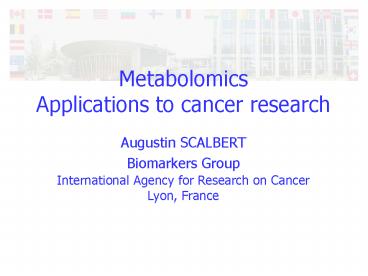Metabolomics Applications to cancer research - PowerPoint PPT Presentation
1 / 21
Title:
Metabolomics Applications to cancer research
Description:
Metabolomics Applications to cancer research Augustin SCALBERT Biomarkers Group Metabolomics, the most downstrean biochemical dimension of biological systems Genome ... – PowerPoint PPT presentation
Number of Views:767
Avg rating:3.0/5.0
Title: Metabolomics Applications to cancer research
1
MetabolomicsApplications to cancer research
- Augustin SCALBERT
- Biomarkers Group
2
Metabolomics,the most downstrean biochemical
dimension of biological systems
Genome
Phenotype
Transcriptome
Environmental influence
Proteome
Metabolome
- Indicator of both genetic and environmental
conditions
3
Metabolome and metabotypes
22 men women 40 urine samples/subject 1H-NMR Can
onical analysis
- Interindividual distances by far larger than
intraindividual distances - A model based on 15 urine fingerprints/per
subject allows to predict with 100 confidence
the donor of an unknown sample
Assfalg et al., 2008, PNAS
4
Metabolomics in cancer research
- A relatively recent field of research
- Various applications
- Mechanisms of carcinogenesis
- Novel clinical biomarkers for cancer
- Diagnosis, prognosis, recurrence
- Discovery of novel risk factors for cancer
- Diet, physical activity, contaminants,
pollutants, occupational exposure
5
Two metabolomic approaches
Untargeted metabolomics
Targeted metabolomics
Mass spectrometry
1H-NMR spectroscopy
Biomarker discovery
Biomarker quantification
6
Metabolome-Wide Association Studies (MWAS)
NHANES cohorts (n500-3300) 266 environmental
factors in urine or plasma Fasting glucose
Patel et al., 2010, Plos One Rappaport, 2012,
Biomarkers
7
Aminoacid profiling and cancer diagnosis
- Gln, Trp and His decreased in all cancers
Miyagi et al., 2011, PLOS One
8
60 fatty acids and breast cancerin the EPIC-E3N
cohort
Nested case-control study in the E3N cohort 384
breast cancer cases / 768 controls 60 fatty acids
by GC
Trans fatty acid quintiles
OR
95CI
161 n-9 trans
1
1.00
3
1.17
0.74-1.83
P 0.0016
5
2.24
1.30-3.86
181 n-9 trans
1
1.00
3
1.02
0.63-1.64
P 0.12
5
1.45
0.90-2.33
161181 n-9 trans
1
1.00
3
1.12
0.71-1.78
P 0.018
5
1.75
1.08-2.83
1
2
- 3 trans-fatty acids associated to breast cancer
risk
Chajès et al, Am J Epidemiol 2008
9
186 endogenous metabolitesin blood, urine and
biopsies
- 10 uL plasma
- 186 metabolites estimated
- Acylcarnitines
- Aminoacids
- Biogenic amines
- Hexoses
- Phosphatidylcholines
- Lysophosphatidylcholines
- Sphingomyelins
- 53 metabolites absolutely quantified (labelled
standards)
Biocrates kit IDQ p180
10
Metabotypes and type 2 diabetes risk
Framingham Offspring Study 12 yrs follow-up 189
cases, 189 matched controls Plasma samples at
baseline 61 metabolites by LC-ESI-MS-MS
Adjusted odd ratios for developing diabetes
- 5 aminoacids predictors of T2DM risk
- Branched chain aminoacids known to promote
insulin resistance
Wang T.J. (2011) Nat. Med.
11
Untargeted metabolomics
12
Diagnosis of epithelial ovarian cancer
Discovery
84 women Fasting sera (180 uL) UPLC-ESI-QTof OPLS-
DA
13 discriminating variables ( 6 metabolites)
Chen J. et al., 2011, J. Proteome Res.
13
Biomarkers of dietary exposure
14
Citrus biomarkers in the SU.VI.MAX2 cohort
OSC-PLS (Log Pareto)
SU.VI.MAX2 Cohort Food Frequency
Questionnaires Low (lt1.5 g/day) and high (gt25
g/day) consumers Spot urine
- 12 discriminating metabolites including proline
betaine, hydroxyproline betaine, naringenin 7-O
glucuronide, hesperetin 3'-O-glucuronide and 2
terpenoids
Manach et al., submitted
15
Dietary biomarkers in the EPIC cohort
EPIC Calibration Study n 494 24-hr Urine
samples collected on same day as
24HDR Diluted to same specific gravity UPLC-QTof
(Agilent 6550) Negative ionization XCMS
Food Frequency questionnaires
24-hr Dietary recalls
Correlations with dietary intake
16
Dietary biomarkers in the EPIC cohort
Catechin Protocatechuic acid sulphate Gallic acid
ethyl ester glucuronide 3-O-Methylcatechin
sulphate Dihydroresveratrol glucuronide
3,4-Dihydroxyphenylvalerolactone
sulfate 3,4-Dihydroxyphenylvalerolactone
glucuronide 3-O-Methyl-4-hydroxyphenylvalerolacton
e sulphate 3-O-Methylcatechin sulphate Epicatechin
glucuronide sulfate
Gallic acid 4-O-Methylgallic acid 4-O-Methylgallic
acid sulfate
Phloretin 2-O-glucuronide
Hesperetin 3-O-glucuronide Hesperetin
3-O-sulfate Naringenin 4-O-glucuronide
17
Biomarkers for coffee consumption
24-hr Dietary recall Food Frequency Questionnaire
18
Metabolomics and cancerConclusions
- A powerful approach to discover new biomarkers
for cancers - Diagnosis, prognosis
- Biomarkers of exposure for cancer risk factors
- MWAS to better understand cancer aetiology
- Mechanisms of carcinogenesis
- Identification of cancer risk factors
- A new metabolomic platform at IARC
- Mass spectrometry
- Data analysis
19
Correlations with food intake
20
IARC platform for metabolomics
- Biomarker discovery
- UPLC-ESI-QTof-MS
- EWAS
- UPLC-ESI-MS-MS
- GC-MS and GC
Augustin Scalbert Sabina Rinaldi Dinesh
Barupal Veronique Chajes Will Edmands David
Achaintre Beatrice Vozar Vanessa Neveu
21
Polyphenol metabolome
- gt500 polyphenols known in foods
- No comprehensive method to analyse them in
biospecimens - No labelled standards available
- Differential isotopic labelling
Collaboration Lian Li (Univ. of Alberta) Support
from INCa (2012-2014)
Urine standard
Urine samples
H313C
13CH3
Polyphenol
Polyphenol















![Global Market Report on Metabolomics: Technologies Industry [2015] PowerPoint PPT Presentation](https://s3.amazonaws.com/images.powershow.com/8338970.th0.jpg?_=201512310411)















